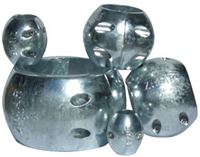- Register
- Log in
- Wishlist 0
- Shopping cart 0You have no items in your shopping cart.
- Check Order Status
Zinc Anodes and Cathodic Protection
Seawater is inherently corrosive and this is even more pronounced in the case of components that are made of two different metals. Any time two metals are in contact in seawater they will form a battery and one of the two metals will give up its electrons to create the current that flows between the two metals. This process is known as galvanic corrosion and unless you want your boat to begin failing you it is important that we halt this process before it begins. This is done by using a third metal which will more readily give up electrons to create a current. In boating zinc is most commonly used and the zinc pieces are called zinc anodes, or more commonly just zincs.
Zinc anodes are used on boats anywhere two metals come in contact with each other and are thus subject to galvanic corrosion. This is most common with a stainless steel shaft and aluminum propeller, but there are many other places where two different metals come in contact on a boat. Without the protection of a zinc anode you risk corrosion seriously affecting your parts and components.

Some people think that as long as zinc is present it will protect the other metals on their boats, however they soon learn to their chagrin that this is not true. You can not protect your metal components by simply hanging a piece of zinc over the side of the boat, the zinc anodes must be in contact with the metals they are protecting. This isn't a big deal though as boat and engine manufactures have designed parts to allow for the inclusion of zinc anodes, from the zinc collar that goes around your shaft to the zinc hull plates that are used to protect bronze through-hull fittings to the various zincs in an engine there is typically a protection wherever there are two metals with the possibility of galvanic corrosion occurring.
Now that you know about the importance of zinc anodes it should also be stressed that these anodes do not last forever. Because they are sacrificing themselves to protect your more important metal parts they corrode themselves and are slowly worn down. As a rule of thumb the zinc anodes should be roughly 1% of the surface area they are protecting and should only need to be replaced annually. To be safe though you should inspect all your metal parts regularly for signs of corrosion and if any is present replace your zincs immediately. Typically zincs are replaced when they are only half consumed. Once they go beyond this they are significantly less effective and you risk damage to the parts you are trying to protect.
The good news is that zinc anodes are not expensive, many cost just several dollars and even larger hull plates can be had for under $30 in many cases.When installing zinc anodes be sure that they are in contact with the metal being protected, do not paint the surface of the zinc and make sure that both the zinc and other metal surface are bare and bright before installing the anode. In the case of your engine you should refer to the owners manual to be sure you know the location of all the zincs, some can be difficult to locate if you aren't aware that they are there.
It is good that there is a way to protect your metal parts, but the protection only lasts as long as you keep your zinc anodes bigger than half depleted. Make it a habit to check for corrosion regularly and replace those zincs when they are half depleted. If you find that this is more than once a year then consider using bigger zincs.




































